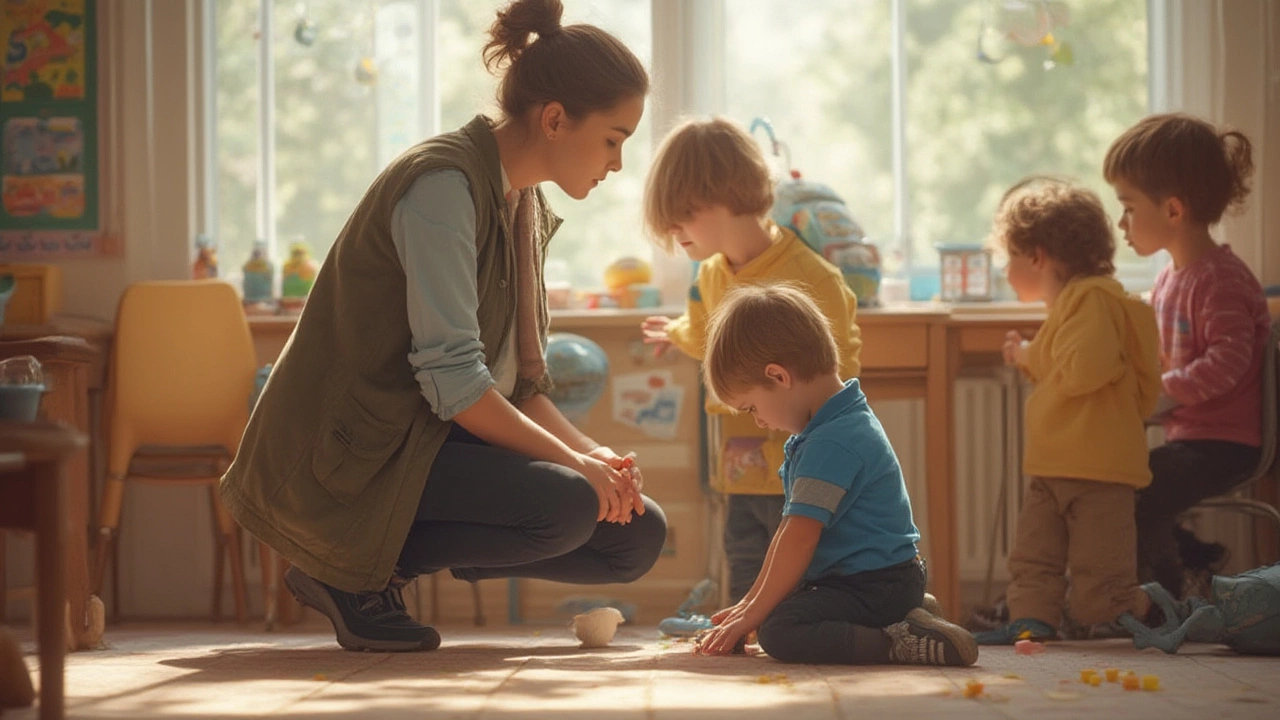Some days, you actually notice the stares—maybe you’re in line at the supermarket, or at the local playground, and your kid suddenly drops to the ground, covers his ears, and shouts. Augustine did just that last week, and right after the storm passed, I wondered: how common is this? How many parents and teachers actually know what to call it, or what to do? Special needs behavior isn’t just a buzzword tossed around at the school gates. It’s something families and educators live with, constantly trying to decode. Let’s break down what a special needs behavior really looks like, with all the messy details.
Defining Special Needs Behavior with Real-World Examples
When people hear “special needs behavior,” the first thing that often pops up is a stereotype. Maybe it’s that kid in the corner, maybe it’s a meltdown, maybe it’s just a lot of energy in the wrong place. The truth is, there’s no one-size-fits-all behavior. That’s what makes it so confusing—and interesting.
Let’s focus on a classic example: repetitive behaviors in children with autism. Imagine a boy who lines up his toy cars, over and over. If anyone moves one, he might get agitated or even upset. Is he being stubborn, or is this a coping mechanism? In the context of special needs behavior, this isn’t about misbehavior—it’s about routine, comfort, and maybe even calming an anxious mind.
Another common example? Impulsive outbursts in a child with ADHD at school. Picture a classroom with 25 kids quietly working, except for the one who can’t stop tapping, calling out answers, or blurting out personal stories. Some see this as distraction or disrespect, but it’s often not intentional. That’s just the stream of thoughts pouring out faster than the brakes can handle.
But what causes these behaviors? Factors like sensory overload, communication problems, medical conditions, or even frustration because the world just doesn’t make sense in the moment. Research in 2022 from Stanford found that up to 70% of kids with autism show repetitive behaviors daily; and the CDC reports that about 1 in 36 children in the US have autism as of 2024. That’s a lot of children, and each one is different.
Now, let’s get practical. Here are some other behaviors you might see:
- Difficulty making eye contact during conversation
- Bolting or running away in crowded spaces
- Obsessive interests in specific objects or topics
- Meltdowns in response to loud sounds or bright lights
- Self-soothing actions like rocking, hand-flapping, or spinning
- Repetitive questions or words
- Trouble switching from one activity to another
If one or more of these ring a bell, you might be seeing special needs behavior first-hand. Each situation calls for different strategies, which we’ll dig into next.
Why These Behaviors Happen: Underlying Causes and Patterns
No one wakes up and decides to be difficult—or at least, very few kids with special needs ever do. So, what’s really going on in that moment when your child bolts from the dinner table or throws a pencil across the classroom?
Start with the senses. Kids with autism, for example, might process sounds, textures, and lights in ways you and I don’t. Watch a child at a busy birthday party: the noise, the strangers, the chaos. All these signals swirl together and can overwhelm even the calmest kid. For kids with sensory processing issues, their brains might treat the hum of fluorescent lights or the scratchy feeling of a tag in their shirt like fire alarms—they can’t filter these things out.
Communication also plays a major part. Imagine being dropped in a country where you don’t speak the language, and every attempt to ask for what you need results in confused looks. Some behaviors, like repetitive talking or scripting phrases, fill a gap where communication skills are struggling to develop. Others, like lashing out, show up when frustration hits a boiling point.
Then there’s emotion regulation. Self-control isn’t just a matter of “trying harder.” ADHD, for example, involves real differences in brain structure and chemicals like dopamine. A 2023 Harvard study using brain scans showed noticeable differences in the prefrontal cortex activity of kids with ADHD, particularly when they tried to delay gratification or control impulses. Meaning, it’s not about effort—it’s about building new skills over time.
And don’t underestimate routine. A simple change—like a different bus driver or swapped math lesson—can throw a child’s world into chaos. Structure and predictability let them feel safe, and any shift looks like a threat.
Here’s a snapshot of common causes, summed up in a quick table for clarity:
| Behavior Example | Possible Cause |
|---|---|
| Hand-flapping | Sensory self-regulation |
| Interrupting in class | Impulse control difficulty (e.g., ADHD) |
| Refusing to change activity | Anxiety, need for routine |
| Running away in crowds | Overwhelm, sensory overload |
| Repeating words/phrases | Communication delay, comfort |
| Hitting/biting | Expression of frustration, lack of coping skills |
Every child’s a puzzle. The key is figuring out which pieces fit for your situation.

Spotting and Responding to Special Needs Behaviors in Everyday Life
If you’re a parent or teacher, you’ve probably felt the panic after a meltdown—the urge to fix things, to apologize, or to discipline. It’s tough not to take it personally, especially when strangers watch or other kids complain. The first step is spotting the early signs before things get out of hand.
Start by keeping a diary. It sounds old-school, but jotting down when, where, and what happened can reveal patterns. Maybe your child always struggles after lunch, or maybe it’s a certain classroom activity that triggers anxiety. This detective work makes a big difference and takes the blame out of the picture.
Watch for physical hints: fidgeting, covering ears, leaving their seat, pacing, or retreating to quiet spaces. For my son, Augustine, repeated finger tapping is the first signal. I’ve learned that when he starts, it’s a warning—something’s off. Teachers tell me the same: subtle cues often come before a big outburst.
When it does happen, resist the instinct to react fast or with anger. Instead, aim for calm. Acknowledge their feelings, even if you don’t understand them: “I see this is hard for you.” Validate, then redirect, if possible. Sometimes just stepping away from the crowd can lower the tension. For sensory triggers, noise-cancelling headphones or a weighted lap pad might help.
It’s worth building a toolbox of coping strategies. Here are a few that actually work for kids and classrooms:
- Visual schedules and timers so routines are predictable
- Safe spaces to cool down—like a quiet corner or tent
- Break cards kids can flash when they feel overwhelmed
- Social stories: simple, illustrated explanations about what will happen and how to react
- Fidget tools or stress balls for busy hands
- Clear, short instructions with step-by-step reminders
- Positive reinforcement—catching them doing the “right” thing and celebrating small wins
For schools, it’s useful to have a plan in place (sometimes called an IEP or Individualized Education Program). This gives kids structure and sets expectations for everyone—not just the child. According to a 2024 UK Department of Education survey, over 60% of teachers say classroom strategies like these cut disruptive incidents in half after implementation.
And remember, “bad” behavior isn’t always about being naughty. It’s a signal. Listening and observing are your best tools—even more than any discipline or consequence system.
Supporting Children and Families: Practical Tips That Make a Difference
The toughest part of navigating special needs behavior isn’t the behavior itself, but the burnout—especially for parents and teachers. You repeat yourself, troubleshoot, then question everything. Is this normal? Am I missing something?
It’s easy to forget self-care, but you’re no good to anyone if you’re running on fumes. Find a support group if you can—online forums, local meetups, or just friends who get it. A 2023 Parent Voices Network poll showed that 71% of families felt less isolated after sharing experiences, even online. Swapping stories helps you breathe.
Don’t go it alone with professionals, either. Even a short meeting with a school psychologist or occupational therapist can unlock new strategies. Therapies that focus on skill-building—like Applied Behavior Analysis (ABA) for autism or Occupational Therapy for sensory issues—give families practical tools. Early intervention matters. According to the CDC, children who started support before age five saw marked improvement in social and emotional skills, sometimes by 50% over two years.
Here are some day-to-day tips that can lighten the load:
- Celebrate progress, not perfection. Tiny victories, like asking for help instead of screaming, count.
- Make time for strengths. If your child loves drawing or dancing, build it into their day. Positive energy spreads fast.
- Communicate openly with caregivers and teachers. The more consistent the support, the better the results—kids pick up on mixed messages fast.
- Practice self-care. When my patience hits the wall, a ten-minute walk or a hot coffee can do wonders. Tag-team with another adult if you can.
- Be patient with setbacks. Development isn’t a straight line. Bad days happen—they don’t erase good ones.
Never underestimate the importance of advocating for your child. If you see a need that isn’t being met—more support in the classroom, extra time for tests, or sensory accommodations—push for it. Most school systems have legal requirements under acts like IDEA in the US or the SEND Code in the UK. Use your voice, document everything, and don’t be afraid to ask questions.
Lastly, show empathy. Teach siblings and classmates to do the same. Sometimes all it takes is kindness to change a difficult day into a good one.
Special needs behaviors can be tough—on everyone. But when we see the “why” behind them, spot the patterns, respond instead of react, and share the journey with others, we take a big step forward—not just for our kids, but for ourselves, too.






